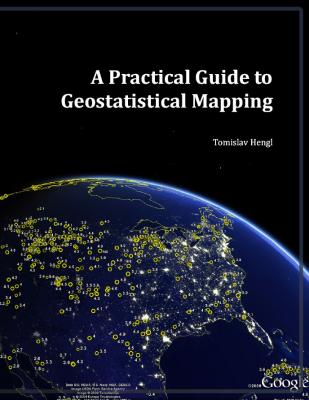
|
FreeComputerBooks.com
Links to Free Computer, Mathematics, Technical Books all over the World
|
|
- Title: A Practical Guide to Geostatistical Mapping
- Author(s) Tomislav Hengl
- Publisher: Lulu.com; eBook (Creative Commons Licensed)
- License(s): Creative Commons License (CC)
- Paperback: 291 pages
- eBook: PDF (293 pages, 10.14 MB)
- Language: English
- ISBN-10: N/A
- ISBN-13: 978-90-9024981-0
- Share This:

|
A practical guide to geostatistical mapping using R+gstat/geoR, SAGA GIS and Google Earth combo of software packages. Includes seven diverse data analysis exercises. Materials presented in this book have been used for the five-day advanced training course "GEOSTAT: spatio-temporal data analysis with R+SAGA+Google Earth", that is periodically organized by the author and collaborators. Visit http://spatial-analyst.net/book/ to obtain a digital copy of the book and R scripts / data sets used. This is an Open Access Publication.
About the Authors- N/A
- Geographic Information System (GIS), Web Mapping, and GPS
- Data Analysis and Data Mining, Big Data
- Statistics and SAS Programming
- Computer Graphics, 3D, Animation and Imaging

- A Practical Guide to Geostatistical Mapping (Tomislav Hengl)
- The Mirror Site (1) - PDF
- The Mirror Site (2) - PDF
- Book Homepage (PDF, etc.)
-
 Geospatial Analysis: Principles, Techniques and Software Tools
Geospatial Analysis: Principles, Techniques and Software Tools
This book provides a compehensive guide to concepts, methods and tools, with many examples being provided using a variety of software tools such as ArcGIS, Idrisi, Grass, Surfer and many others to clarify the concepts discussed
-
 Python Scripting for Spatial Data Processing (Pete Bunting, et al)
Python Scripting for Spatial Data Processing (Pete Bunting, et al)
This book is a Python tutorial for beginners aiming at teaching spatial data processing. It is used as part of the courses taught in Remote Sensing and GIS, using psycopg2, and ogr2ogr, etc., at Aberystwyth University, UK.
-
 Geospatial Analysis with Python (Ujaval Gandhi)
Geospatial Analysis with Python (Ujaval Gandhi)
Suitable for GIS practitioners with no programming background or python knowledge. The course will introduce basic Python programming concepts, libraries for spatial analysis, geospatial APIs and techniques for building spatial data processing pipelines.
-
 Spatial Thinking in Planning Practice: An Introduction to GIS
Spatial Thinking in Planning Practice: An Introduction to GIS
The goals of this textbook are to help students acquire the technical skills of using software and managing a database, and develop research skills of collecting data, analyzing information and presenting results.
-
 Nature of Geographic Information Systems (David DiBiase)
Nature of Geographic Information Systems (David DiBiase)
The purpose of this book is to promote understanding of the Geographic Information Science and Technology enterprise (GIS&T, also known as 'geospatial'). It explores the nature of geographic information.
-
 An Introductory Textbook on Geographic Information Systems
An Introductory Textbook on Geographic Information Systems
This textbook is an introduction to GIS, but most of the chapter's concepts are also applicable to other geotechnologies including remote sensing, global positioning systems (GPS), Internet mapping, and virtual globes.
-
 Geographic Information System Basics (Jonathan Campbell)
Geographic Information System Basics (Jonathan Campbell)
From the melting of the polar ice caps to privacy issues associated with mapping, this book provides a gentle, yet substantive, introduction to the use and application of digital maps, mapping, and GIS.
-
 Principles of Geographic Information Systems (GIS)
Principles of Geographic Information Systems (GIS)
This book is designed to provide students in a first or second GIS course with a solid foundation in both GIS concepts and the use of GIS. It strikes a careful balance between GIS concepts and hands-on applications.
-
 GIS Succinctly (Peter Shaw)
GIS Succinctly (Peter Shaw)
This book guides you through it all, starting with a detailed examination of the data and processes that constitute the internals of a GIS. It surveys a selection of commercial and open-source software packages, detailing the strengths and weaknesses of each.
-
 Google Earth Engine Applications (Lalit Kumar, et al)
Google Earth Engine Applications (Lalit Kumar, et al)
It show apps using the Google Earth Engine in mining, storing, retrieving and processing spatial data for a variety of applications that include vegetation monitoring, cropland mapping, ecosystem assessment, and gross primary productivity, among others.
-
 Cartography - A Tool for Spatial Analysis (Carlos Bateira)
Cartography - A Tool for Spatial Analysis (Carlos Bateira)
This book presents several contributions at different areas and activities showing the importance of the cartography to the perception and organization of the territory, showing the importance of the cartography to the perception and organization of the territory.
-
 Application of Geographic Information Systems (GIS)
Application of Geographic Information Systems (GIS)
This book blends together the theories of GIS and their practical implementations in different conditions. It deals with GIS's application in the broad spectrum of geospatial analysis and modeling, water resources analysis, land use analysis, and such.
-
 Google Maps API Succinctly (Mark Lewin)
Google Maps API Succinctly (Mark Lewin)
It gives you a hands-on, beginner-level introduction to developing mapping applications using the Google Maps JavaScript API. Learn the ins and outs of the API so that you can harness the power of Google Maps within your own websites and applications.
-
 Applications of Spatial Statistics (Ming-Chih Hung)
Applications of Spatial Statistics (Ming-Chih Hung)
Spatial statistics has been widely used in many environmental studies. This book is for people who are interested in applying statistics to spatial data, as well as for who know statistics and want to explore how it can be applied to spatial data.
-
 Applied Spatial Data Analysis with R (Roger S. Bivand, et al)
Applied Spatial Data Analysis with R (Roger S. Bivand, et al)
It presents R packages, functions, classes and methods for handling spatial data, and showcases more specialised kinds of spatial data analysis, including spatial point pattern analysis, interpolation and geostatistics, areal data analysis and disease mapping.





